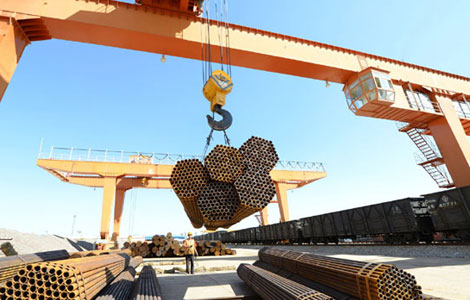New lease on life for ancient buildings
Updated: 2013-08-12 07:17
By He Na and Hu Meidong (China Daily)
|
||||||||
|
 |
|
A bird’s eye view of tulou in Yongding county, Fujian province. PHOTO BY ZOU HONG / CHINA DAILY |
Complexes are architectural wonders that attract tourists, He Na and Hu Meidong report from Yongding county in Fujian.
An old story still raises a chuckle among tulou residents in Longyan, Fujian province.
It goes like this: Satellite images of tulou clusters once made some countries nervous because they thought the giant mushroomlike structures resembled nuclear shelters and they feared the complex was a Chinese missile base.
Those doubts were quickly dispelled when visitors arrived at the site soon after China began its reform and opening-up policy in the late 1970s.
Literally "earthen structures", a tulou typically comprises an earthen outer wall and an internal wooden framework. The circular design usually surrounds a central shrine, and several hundred people live in a single complex.
Tulou are dwellings in the mountainous areas of southeastern Fujian that date back to the 12th century. They are designed to house large communities and to serve as a defense against invasion. The large structures have survived wars and natural disasters.
There are about 23,000 tulou in Yongding county and about 15,000 in Nanjing county.
Lin Rigeng, 63, one of the owners of Zhencheng Lou in Hongkeng village, recalled that until the early 1990s there was no road linking the village to the outside world and few villagers had even seen a bicycle.
According to Lin, who is also known as the Prince of the Hakka Tulou, what is now a 10-minute drive to Hukeng town used to be a half-day walk along the zigzagging mountain roads.
"Even so, back then there were some backpackers from both China and abroad who came a long way just to take a close look at, and live in our tulou for a couple of nights," he said.
"We Hakka people are hospitable. In the olden days, when visitors came we welcomed them warmly with free tea, food and accommodation."
|
 |
|
Lin Rigeng, a tulou owner in Yongding county, Fujian province, introduces visitors to the ancient dwelling complex. PHOTO BY ZOU HONG / CHINA DAILY |
To the local people who grew up in the tulou, the structures are just normal houses. But through his conversations with visitors, Lin grew to realize that each tulou is an extraordinary piece of architecture.
"What surprised me most is that people were really interested in our group lifestyle," he said. "They thought it incredible that so many people could live together in harmony."
As tourist numbers soared, Lin couldn't afford to provide his services gratis, so he started charging a fee to cover his costs. Spotting a business opportunity, he gave up farming and entered the tourism industry in the late 1990s.
Lin is happy to relate stories about the tulou. He explains about the buildings in a passionate way that impresses visitors and many have subsequently become his friends.
Lin has a habit of making notes about visitors' comments so he can improve his skills as a tour guide. After years of collating these notes, he has developed a series of tour commentaries that are used by all the guides in Yongding.
Fujian tulou clusters consist of different-sized circular and rectangular buildings with faded yellow clay walls. Surrounded by enchanting mountains and streams, the dark brown wooden roofs look magnificent at sunset.
The buildings are arranged in a way that enables them to blend in with the environment, providing first-time visitors with breathtaking views and peace and quiet.
The best-known examples are: Zhencheng Lou, where Lin lives; Jiqing Lou, the area's oldest earth building which has a history of 580 years; and Chengqi Lou, the largest tulou on the site.
According to tulou expert Xu Songsheng, the Hakka people have a strong sense of ancestry. The people living in the tulou are all descended from a common ancestor. The buildings' circular or rectangular shapes comprise an axis line, a gate, a central section, a courtyard and the main building.
|
 |
| Residents are proud to live in the tulou. |
|
 |
| Su Haoyu (left), 74 and 58-year-old Jiang Dailian grew up in the old building and have lived in it all their lives. |

 Spanish skyscraper forgets elevator
Spanish skyscraper forgets elevator
 Beijing rainstorm cancels flights, kills airport worker
Beijing rainstorm cancels flights, kills airport worker
 highs and lows of marine rescue
highs and lows of marine rescue
 Lin Dan wins Olympic final rematch over injured Lee
Lin Dan wins Olympic final rematch over injured Lee
 Northeast China braces for major floods
Northeast China braces for major floods
 High-heeled, well heeled
High-heeled, well heeled
 Thunder storm hits Beijing, darkening the sky
Thunder storm hits Beijing, darkening the sky
 Fans stay away as worlds get off to sweaty start
Fans stay away as worlds get off to sweaty start
Most Viewed
Editor's Picks

|

|

|

|

|

|
Today's Top News
New green policy gives industries a big boost
Northeast China braces for major floods
Launches highlight India's ambitions
Chinese put on alert in Afghanistan
Questioning China's achievements
Go-between helped to cement deal
The only way now is up
Japan to carry out self-defense
US Weekly

|

|




